 What actually wines are?
What actually wines are?Describing a wine compares to writing a poem, not as easy as it seems!!!!!!!!!
Basically a wine is an alcoholic beverage which is being prepared by carrying the fermentation process on grapes with the help of yeast.Yeast consumes the sugars found in the grapes and converts them into alcohol, but the main difference between wine and other alcoholic beverages is that it contains a very less amount of alcohol in it by volume which is near 8-12% by vol.
Wine manufacturing:
Wine is a product made from fruits like grapes, berries etc by drying them and later fermenting them. When the grapes ferment the sugar in the grapes convert to alcohol. They are available in various colors and textures depending upon the elements present in them. For example, the wine exhibits a reddish color when the seeds and the skin of the grapes are present during the fermentation process. When it is fermented without any quantity of non-juicy parts they turn pinkish.
The three main categories in wine are fortified wine, sparkling wine or table wine. It is known as a fortified wine when a little brandy is added to enrich the alcoholic content. It is termed as still or sparkling depending upon the CO2 quantity. Table wine is available in a very natural form and is not like the other wine.
Grapes are usually the best ingredients used in the preparation of wine. There is an equal proportion of sugar and acid in them, which cannot be found in any other fruit. High temperature heat is required to dry away the grapes. You must have a thorough knowledge regarding the exact harvesting season. If the harvesting is delayed you may not be able to produce a good quality wine because the level of sugar increases and the acidic extent gets too low.
At the initial stage of processing, the grapes are crushed using a large cylindrical container that inflates the juicy part of the grapes in the large bags that are attached. They are then fermented by heating the juicy part. In the process of heating the yeast that is present helps converting the sugar into alcohol and carbon dioxide. Sometimes this solution requires fermentation for the second time due to malic acid present. When the malic acid breaks downs into lactic acid and carbon dioxide, it adds a new buttery flavor to the wine.
The next step carried out is to settle all the particles like yeast cells, or any other material flowing on the top layer. It is then filtered and all the sediments are gathered on the filter. Winery aging is the process where the wine is tightly packed in containers not allowing the air to enter in them for nearly several months and sometimes years. The wine is then transferred in small bottles and sold.


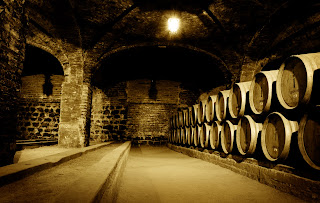 Bottling is done in such a way that it becomes easy to identify the various types of wine. Also colored bottles reduce the chances of damage, oxidation and many other risks.
Bottling is done in such a way that it becomes easy to identify the various types of wine. Also colored bottles reduce the chances of damage, oxidation and many other risks.
After buying a wine product it is important to store it in a right place. Usually damp and cool places like underground cellars are more appropriate. There are some underlying principles regarding the storage of wine. It should be stored in a cellar at a temperature of about 55 degrees Fahrenheit. If the temperature fluctuates it will harm the quality of wine. Humidity about 60 % is necessary to keep the cork moist. Low temperatures will slow the process. Wine should be kept away from external sources like light, vibration and strong odors, which are obviously the barriers to the formation of a good quality wine.
Types of Grapes used for wine making:
Understanding the types of grapes used in wine and their characteristics is vital for any relevant knowledge of wine. Apart from white and Black grapes come from two main families.
Vitis Vinifera, which is prevalent in Europe, and
Vitis Labrusca, which is native to Canada and the eastern United States.
There are over 5,000 varieties of wine grapes. Below are some of the main types, if you click on the two links above you will get a much more in depth description of the links between grape varieties.
SOME OF THE BEST GRAPES:
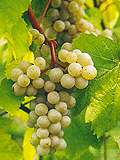 AUXERROIS: Also known as Malbec or Cot, Auxerrois creates a neutral wine, fruity and soft. It is mainly grown in Luxembourg and Canada. In Alsace it is ofted blended with the PINOT BLANC grape.
AUXERROIS: Also known as Malbec or Cot, Auxerrois creates a neutral wine, fruity and soft. It is mainly grown in Luxembourg and Canada. In Alsace it is ofted blended with the PINOT BLANC grape.
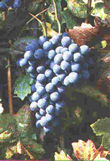 BARBERA: Barbera is a low-tannin grape known for its tarry flavor. It is very widely planted - in California it's about equal with MERLOT GRAPE vines, while in its home in Italy it has more acerage than SANGIOVESE and NEBBIO Piedmont is especially well known for this grape.
BARBERA: Barbera is a low-tannin grape known for its tarry flavor. It is very widely planted - in California it's about equal with MERLOT GRAPE vines, while in its home in Italy it has more acerage than SANGIOVESE and NEBBIO Piedmont is especially well known for this grape.
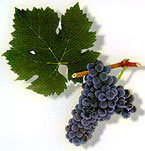 CABERNET FRANC: A "parent" of the CABERNET SOVIGNON FRANC
CABERNET FRANC: A "parent" of the CABERNET SOVIGNON FRANC
. Cabernet Franc is used in Bordeaux - added in small amounts for flavor. It is also used in the Loire Valley, where it is called Breton. Other names include Bouchy, Bouchet, Gros Bouchet and Veron.
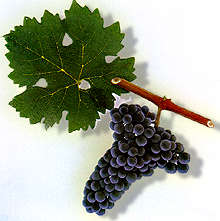 CABERNET SAUVIGNON: Sauvignon wines are made from these grapes - on the vine they are red, small, and tough. The wines tend to taste like blackberries and cedar. Bordeaux uses the Cabernet Sauvignon grape, usually mixed in with MERLOT. These grapes are also grown widely in California and Australia. The grape contains a lot of tannin, which leads to a good red wine when properly aged.
CABERNET SAUVIGNON: Sauvignon wines are made from these grapes - on the vine they are red, small, and tough. The wines tend to taste like blackberries and cedar. Bordeaux uses the Cabernet Sauvignon grape, usually mixed in with MERLOT. These grapes are also grown widely in California and Australia. The grape contains a lot of tannin, which leads to a good red wine when properly aged.
 CHARDONNAY: is a fresh, fruity grape grown in Burgundy, Champagne, California, Australia, and South Africa. Chardonnay wine tends to taste like fruits - melon, peach, etc. - and also many have an oaky flavor. It is one of the most popular and easiest to grow white grapes - it buds early, grows easily and has high ripeness levels.
CHARDONNAY: is a fresh, fruity grape grown in Burgundy, Champagne, California, Australia, and South Africa. Chardonnay wine tends to taste like fruits - melon, peach, etc. - and also many have an oaky flavor. It is one of the most popular and easiest to grow white grapes - it buds early, grows easily and has high ripeness levels.
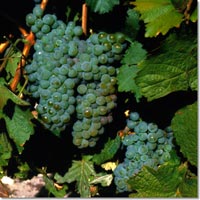 CHENIN BLANC: This grape makes a light, fruity wine. It is planted primarily in the US and in the Loire valley of France (well known in Vouvray wine). In South Africa this grape is referred to as Steen. Also known as White Pinot (Pinot Blanco), Chenin Blanc is able to age ten years or more.
CHENIN BLANC: This grape makes a light, fruity wine. It is planted primarily in the US and in the Loire valley of France (well known in Vouvray wine). In South Africa this grape is referred to as Steen. Also known as White Pinot (Pinot Blanco), Chenin Blanc is able to age ten years or more.
How a wine is had:
Step 1 - Look Fill the glass about one-third full, never more than half-full. Pick it up by the stem. This may feel awkward at first, but there are good reasons: Holding the glass by its bowl hides the liquid from view; fingerprints blur its color; the heat of your hand alters the wine's temperature. Wine experts can usually tell right away how much a person knows about wine by the way the glass is held. Focus on the hue, intensity and clarity of the wine color. The true color, or hue, of the wine is best judged by tilting the glass and looking at the wine through the rim, to see the variation from the deepest part of the liquid to its edges. Intensity can best be gauged looking straight down through the wine from above. Clarity - whether the wine is brilliant, or cloudy with particles - is most evident when light is shining sideways through the glass.
Fill the glass about one-third full, never more than half-full. Pick it up by the stem. This may feel awkward at first, but there are good reasons: Holding the glass by its bowl hides the liquid from view; fingerprints blur its color; the heat of your hand alters the wine's temperature. Wine experts can usually tell right away how much a person knows about wine by the way the glass is held. Focus on the hue, intensity and clarity of the wine color. The true color, or hue, of the wine is best judged by tilting the glass and looking at the wine through the rim, to see the variation from the deepest part of the liquid to its edges. Intensity can best be gauged looking straight down through the wine from above. Clarity - whether the wine is brilliant, or cloudy with particles - is most evident when light is shining sideways through the glass.

Next comes the swirling. This too can feel unnatural, even dangerous if your glass it too full and
 your carpet or clothing is new. But besides stirring up the full range of colors, it lets the wine breathe a little and releases some of the aroma for examination. The easiest way to swirl is to rest the base of the glass on a table, hold the stem between thumb and forefinger, and gently rotate the wrist. Right-handers will find a counter-clockwise motion easiest, left-handers the reverse. Move the glass until the wine is dancing, climbing nearly to the rim. Then stop. As the liquid settles back into the bottom of the glass, a transparent film will appear on the inside of the bowl, known as the wine's "tears" or "legs." You will often hear people pondering about the legs or showing them off, "Hey look at the legs on this wine!" They are simply an indication of the amount of alcohol in the wine: the more alcohol, the more tears or legs.
your carpet or clothing is new. But besides stirring up the full range of colors, it lets the wine breathe a little and releases some of the aroma for examination. The easiest way to swirl is to rest the base of the glass on a table, hold the stem between thumb and forefinger, and gently rotate the wrist. Right-handers will find a counter-clockwise motion easiest, left-handers the reverse. Move the glass until the wine is dancing, climbing nearly to the rim. Then stop. As the liquid settles back into the bottom of the glass, a transparent film will appear on the inside of the bowl, known as the wine's "tears" or "legs." You will often hear people pondering about the legs or showing them off, "Hey look at the legs on this wine!" They are simply an indication of the amount of alcohol in the wine: the more alcohol, the more tears or legs.Step 3 - Smell
When you stop swirling, and the legs are falling, it's time to take the next step: smelling. Swirling the wine vaporizes it, and the thin sheet of liquid on the sides of the glass evaporates rapidly; the result is an intensification of the aromas.
 I'm sure you've seen wine snobs do this and you have laughed at them, but stick your nose right into the bowl and inhale.
I'm sure you've seen wine snobs do this and you have laughed at them, but stick your nose right into the bowl and inhale.There's no consensus about the proper sniffing technique. Some advocate two or three quick inhalations; others prefer one deep, sharp sniff. I've seen tasters close one nostril, sniff, then close the other and sniff again. It really doesn't matter how you do it as long as you get a good whiff. With practice, and keen attention, you'll learn how to maximize your perception of aromas, and then how to decipher them.
The world of smell is vast and bewildering. First of all, our olfactory equipment is incredibly sensitive; we can distinguish aromas in quantities so small that laboratory equipment can scarcely measure them. Second, our analytic capacity is extraordinary; estimates of the number of different smells humans can identify range up to 10,000!
As with color, wine's aromas offer insights into character, origin and history. Because our actual sense of taste is limited to four simple categories (sweet, sour, bitter and salt), aroma is the most revealing aspect of our examination. But don't simply sniff for clues. Revel in the sensation. Scientists say smells have direct access to the brain, connecting immediately to memory and emotion. Like a lover's perfume, or the scent of cookies from childhood, wine's aromas can evoke a specific place and time with uncanny power.
STEP 4 - Taste

With the aromas still reverberating through your senses, put the glass to your lips and taste. How much? You need to have enough volume to work it all around your tasting apparatus, but not so much that you're forced to swallow right away. Because you don't want to swallow, not just yet. It takes time and effort to force the wine to divulge its secrets. I keep a pleasant wine in my mouth for 10 to 15 seconds, sometimes more.
Roll the wine all around your mouth, bringing it into contact with every part, because each decodes a different aspect of the liquid. Wine provokes sensations, too: the astringency of tannins is most perceptible on the inner cheeks; the heat of the alcohol burns in the back of the throat.
First, as you hold the wine in your mouth, purse your lips and inhale gently through them. This creates a bubbling noise children find immensely amusing. It also accelerates vaporization, intensifying the aromas. Second, chew the wine vigorously, sloshing it around in your mouth, to draw every last nuance of flavor from the wine.
Don't forget the finish. After you swallow, exhale gently and slowly through both your nose and mouth. The retro-nasal passage, which connects the throat and the nose, is another avenue for aromas, which can linger long after the wine is finally swallowed. You'll find that the better the wine, the more complex, profound and long-lasting these residual aromas can be. With great wines, sensitive tasters and minimal distractions, the finish can last a minute or more. It's a moment of meditation and communion that no other beverage can create.
Some best wines of the world:
10 – Mendoza, Argentina
9 – Coonawarra, Australia
8 – Priorat, Spain
7 – Tuscany, Italy
6 – Châteauneuf-du-Pâpe, France
5 – Alsace, France
4 – Rutherford, Napa Valley
3 – Bordeaux, France
2 – Mosel, Germany
1 – Burgundy, Champagne and the Loire Valley, France
So next time when ever you have a wine just don't have it be it. (*_*)